Page 728 of 2267
Wiring DiagramNCEC0519
YEC787
: Detectable line for DTC
: Non-detectable line for DTC
ECM INTAKE VALVE
TIMING CONTROL
SOLENOID
VA LV EFUSE
BLOCK
(J/B)Refer to
EL-POWER. IGNITION SWITCH
ON or START
Refer to last page (Foldout page)
.IVC
D T C P 1111 I N TA K E VA LV ETIMING CONTROL
SOLENOID VALVEQG16I18DE
Wiring Diagram
EC-286
Page 729 of 2267
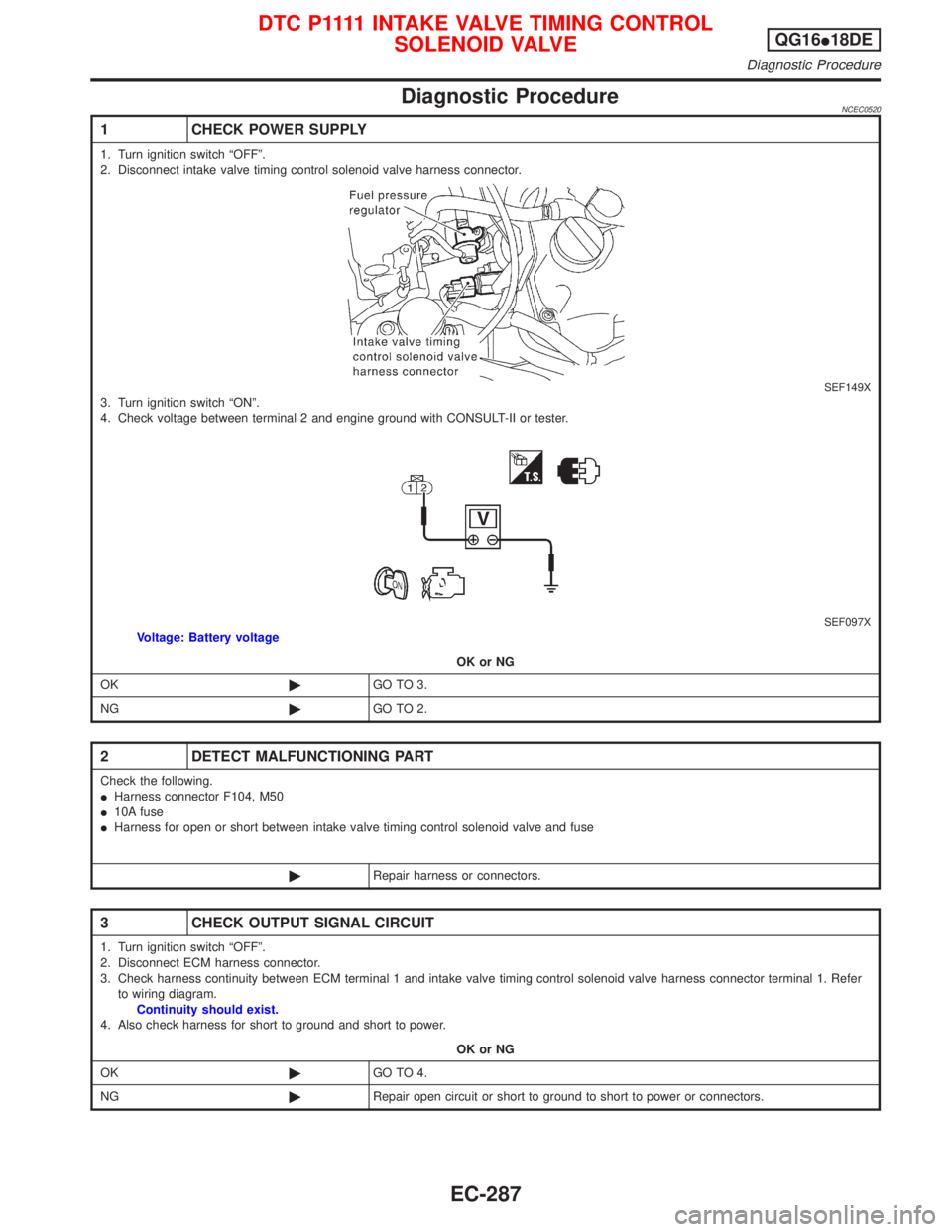
Diagnostic ProcedureNCEC0520
1 CHECK POWER SUPPLY
1. Turn ignition switch ªOFFº.
2. Disconnect intake valve timing control solenoid valve harness connector.
SEF149X3. Turn ignition switch ªONº.
4. Check voltage between terminal 2 and engine ground with CONSULT-II or tester.
SEF097XVoltage: Battery voltage
OK or NG
OK©GO TO 3.
NG©GO TO 2.
2 DETECT MALFUNCTIONING PART
Check the following.
IHarness connector F104, M50
I10A fuse
IHarness for open or short between intake valve timing control solenoid valve and fuse
©Repair harness or connectors.
3 CHECK OUTPUT SIGNAL CIRCUIT
1. Turn ignition switch ªOFFº.
2. Disconnect ECM harness connector.
3. Check harness continuity between ECM terminal 1 and intake valve timing control solenoid valve harness connector terminal 1. Refer
to wiring diagram.
Continuity should exist.
4. Also check harness for short to ground and short to power.
OK or NG
OK©GO TO 4.
NG©Repair open circuit or short to ground to short to power or connectors.
D T C P 1111 I N TA K E VA LV ETIMING CONTROL
SOLENOID VALVEQG16I18DE
Diagnostic Procedure
EC-287
Page 730 of 2267
4 CHECK VALVE TIMING CONTROL SOLENOID VALVE
Refer to ªComponent Inspectionº, EC-QG-288.
OK or NG
OK©GO TO 5.
NG©Replace valve timing control solenoid valve.
5 CHECK INTERMITTENT INCIDENT
Perform ªTROUBLE DIAGNOSIS FOR INTERMITTENT INCIDENTº, EC-QG-102.
©INSPECTION END
Component InspectionNCEC0521INTAKE VALVE TIMING CONTROL SOLENOID VALVENCEC0521S011. Check oil passage visually for any metal debris.
2. Supply intake valve timing control solenoid valve terminals with
battery voltage.
3. Make sure that inside plunger protrudes.
If NG, replace intake valve timing control solenoid valve.
SEF524T Intake valve timing
control solenoid valve
Plunger
FUSE
D T C P 1111 I N TA K E VA LV ETIMING CONTROL
SOLENOID VALVEQG16I18DE
Diagnostic Procedure (Cont'd)
EC-288
Page 731 of 2267
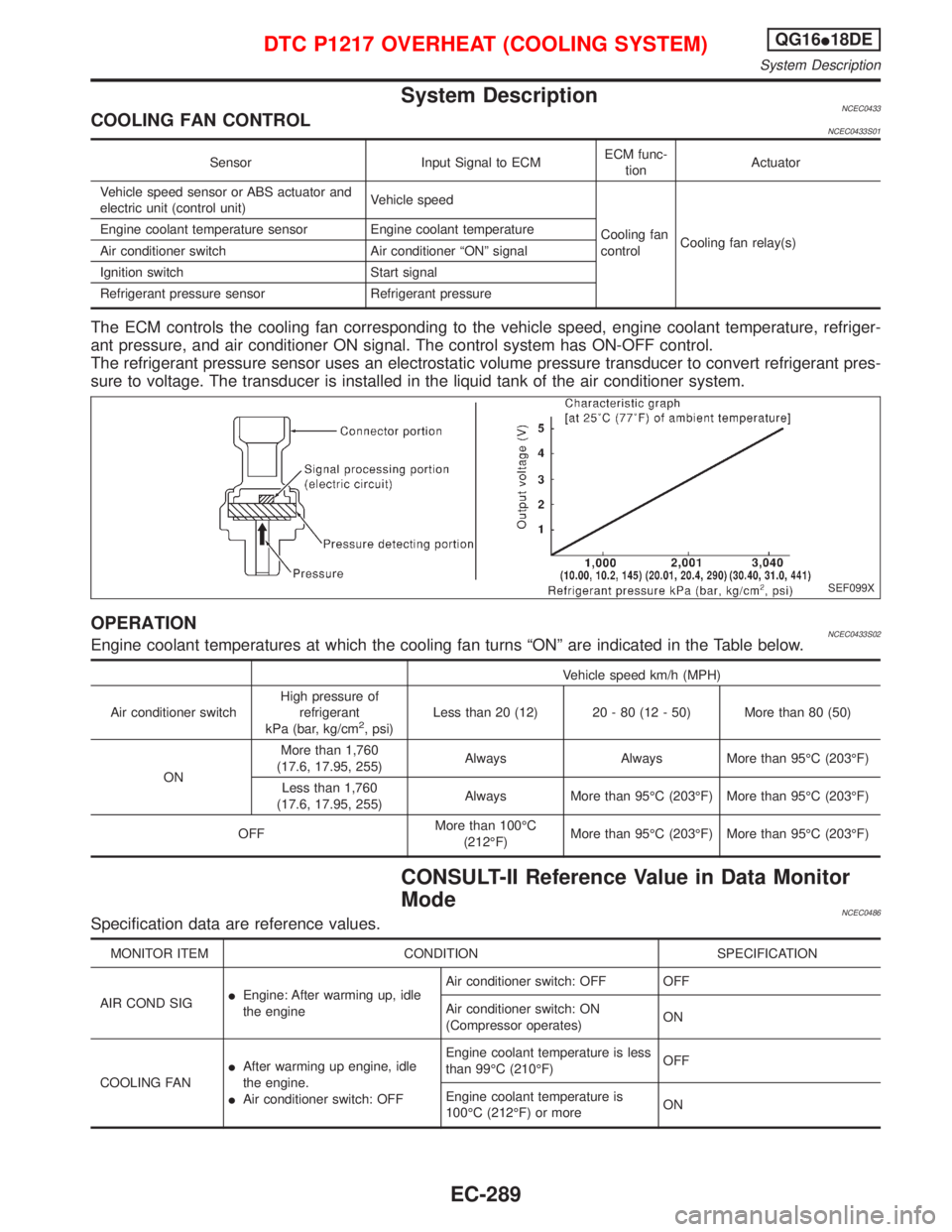
System DescriptionNCEC0433COOLING FAN CONTROLNCEC0433S01
Sensor Input Signal to ECMECM func-
tionActuator
Vehicle speed sensor or ABS actuator and
electric unit (control unit)Vehicle speed
Cooling fan
controlCooling fan relay(s) Engine coolant temperature sensor Engine coolant temperature
Air conditioner switch Air conditioner ªONº signal
Ignition switch Start signal
Refrigerant pressure sensor Refrigerant pressure
The ECM controls the cooling fan corresponding to the vehicle speed, engine coolant temperature, refriger-
ant pressure, and air conditioner ON signal. The control system has ON-OFF control.
The refrigerant pressure sensor uses an electrostatic volume pressure transducer to convert refrigerant pres-
sure to voltage. The transducer is installed in the liquid tank of the air conditioner system.
OPERATIONNCEC0433S02Engine coolant temperatures at which the cooling fan turns ªONº are indicated in the Table below.
Vehicle speed km/h (MPH)
Air conditioner switchHigh pressure of
refrigerant
kPa (bar, kg/cm
2, psi)Less than 20 (12) 20 - 80 (12 - 50) More than 80 (50)
ONMore than 1,760
(17.6, 17.95, 255)Always Always More than 95ÉC (203ÉF)
Less than 1,760
(17.6, 17.95, 255)Always More than 95ÉC (203ÉF) More than 95ÉC (203ÉF)
OFFMore than 100ÉC
(212ÉF)More than 95ÉC (203ÉF) More than 95ÉC (203ÉF)
CONSULT-II Reference Value in Data Monitor
Mode
NCEC0486Specification data are reference values.
MONITOR ITEM CONDITION SPECIFICATION
AIR COND SIGIEngine: After warming up, idle
the engineAir conditioner switch: OFF OFF
Air conditioner switch: ON
(Compressor operates)ON
COOLING FANIAfter warming up engine, idle
the engine.
IAir conditioner switch: OFFEngine coolant temperature is less
than 99ÉC (210ÉF)OFF
Engine coolant temperature is
100ÉC (212ÉF) or moreON
SEF099X
DTC P1217 OVERHEAT (COOLING SYSTEM)QG16I18DE
System Description
EC-289
Page 733 of 2267
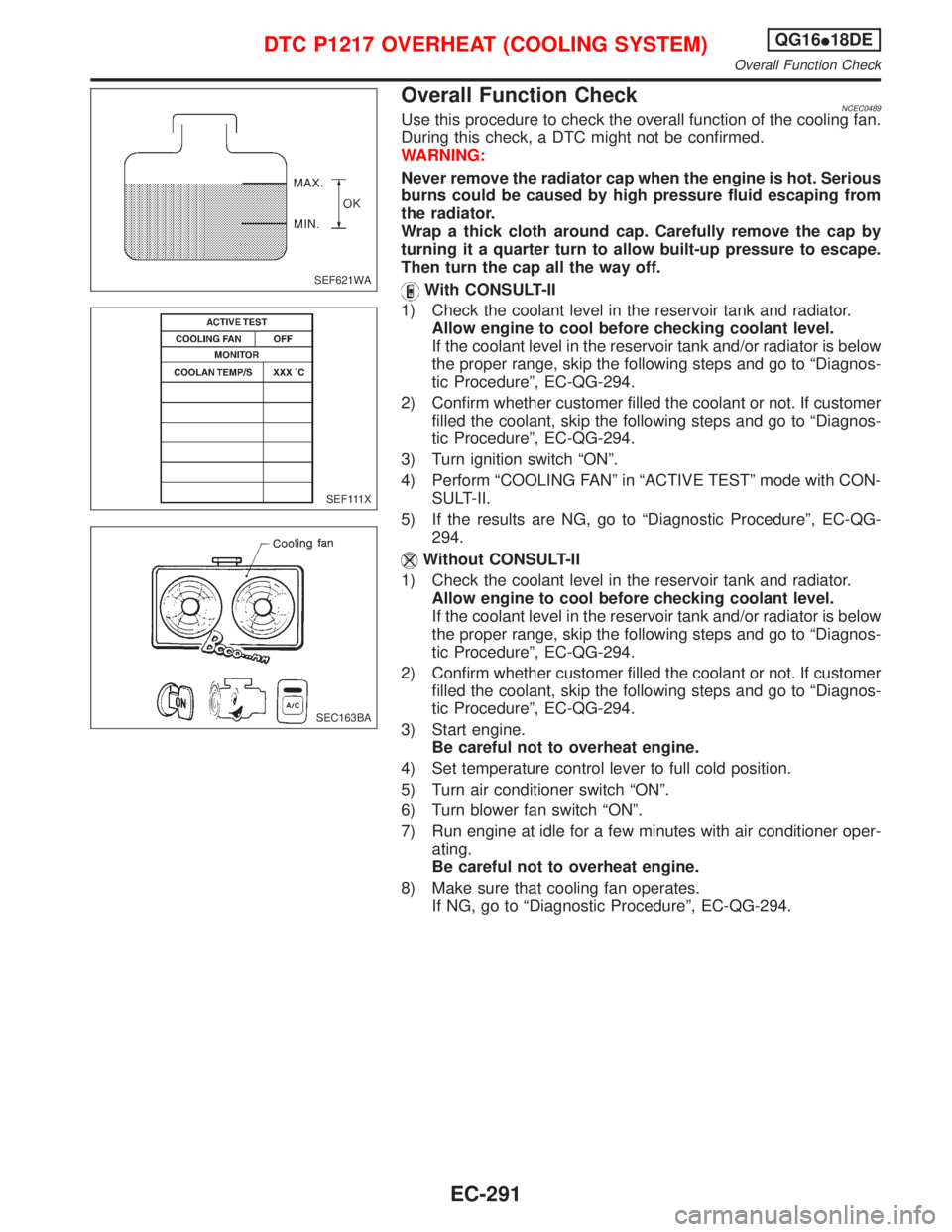
Overall Function CheckNCEC0489Use this procedure to check the overall function of the cooling fan.
During this check, a DTC might not be confirmed.
WARNING:
Never remove the radiator cap when the engine is hot. Serious
burns could be caused by high pressure fluid escaping from
the radiator.
Wrap a thick cloth around cap. Carefully remove the cap by
turning it a quarter turn to allow built-up pressure to escape.
Then turn the cap all the way off.
With CONSULT-II
1) Check the coolant level in the reservoir tank and radiator.
Allow engine to cool before checking coolant level.
If the coolant level in the reservoir tank and/or radiator is below
the proper range, skip the following steps and go to ªDiagnos-
tic Procedureº, EC-QG-294.
2) Confirm whether customer filled the coolant or not. If customer
filled the coolant, skip the following steps and go to ªDiagnos-
tic Procedureº, EC-QG-294.
3) Turn ignition switch ªONº.
4) Perform ªCOOLING FANº in ªACTIVE TESTº mode with CON-
SULT-II.
5) If the results are NG, go to ªDiagnostic Procedureº, EC-QG-
294.
Without CONSULT-II
1) Check the coolant level in the reservoir tank and radiator.
Allow engine to cool before checking coolant level.
If the coolant level in the reservoir tank and/or radiator is below
the proper range, skip the following steps and go to ªDiagnos-
tic Procedureº, EC-QG-294.
2) Confirm whether customer filled the coolant or not. If customer
filled the coolant, skip the following steps and go to ªDiagnos-
tic Procedureº, EC-QG-294.
3) Start engine.
Be careful not to overheat engine.
4) Set temperature control lever to full cold position.
5) Turn air conditioner switch ªONº.
6) Turn blower fan switch ªONº.
7) Run engine at idle for a few minutes with air conditioner oper-
ating.
Be careful not to overheat engine.
8) Make sure that cooling fan operates.
If NG, go to ªDiagnostic Procedureº, EC-QG-294.
SEF621WA
SEF111X
SEC163BA
DTC P1217 OVERHEAT (COOLING SYSTEM)QG16I18DE
Overall Function Check
EC-291
Page 742 of 2267
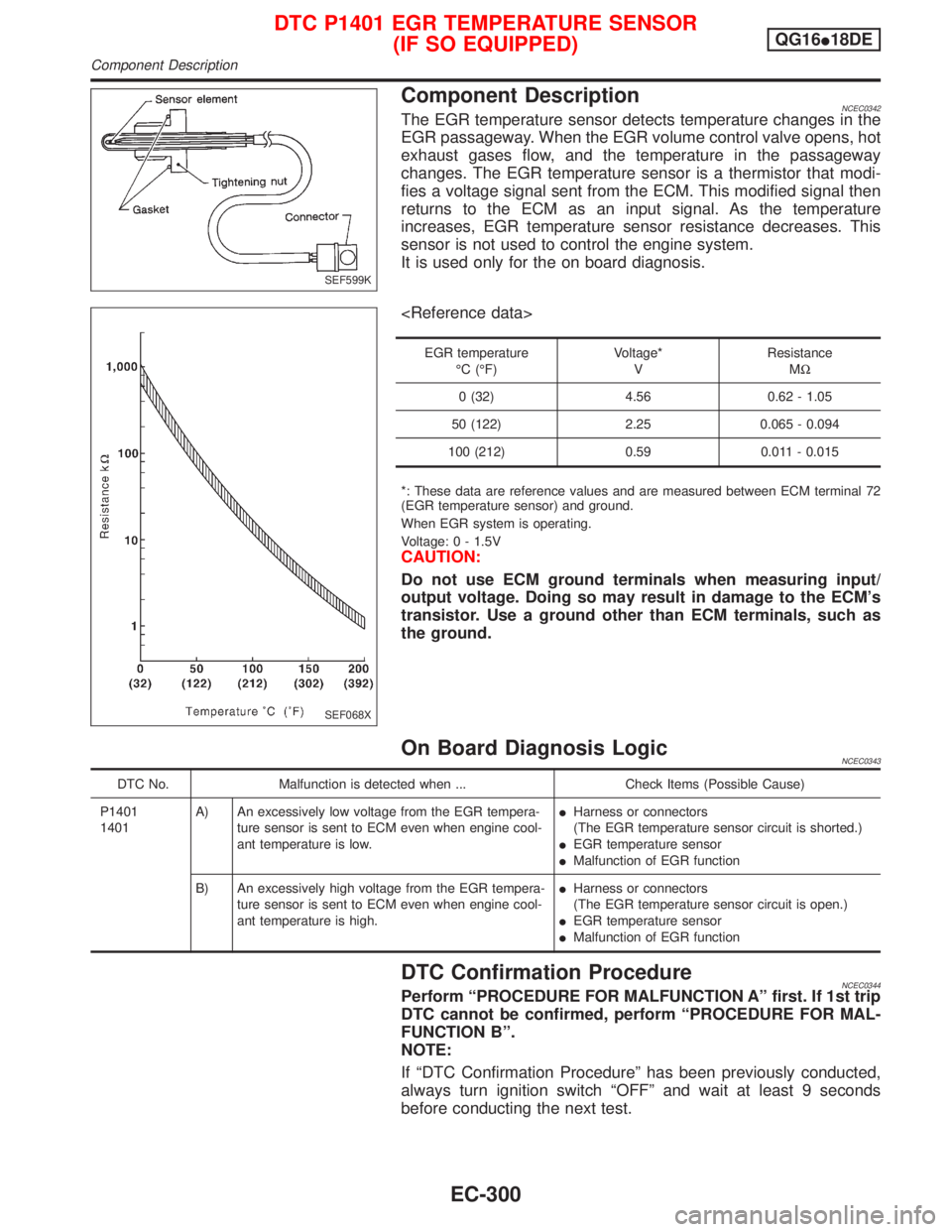
Component DescriptionNCEC0342The EGR temperature sensor detects temperature changes in the
EGR passageway. When the EGR volume control valve opens, hot
exhaust gases flow, and the temperature in the passageway
changes. The EGR temperature sensor is a thermistor that modi-
fies a voltage signal sent from the ECM. This modified signal then
returns to the ECM as an input signal. As the temperature
increases, EGR temperature sensor resistance decreases. This
sensor is not used to control the engine system.
It is used only for the on board diagnosis.
EGR temperature
ÉC (ÉF)Voltage*
VResistance
MW
0 (32) 4.56 0.62 - 1.05
50 (122) 2.25 0.065 - 0.094
100 (212) 0.59 0.011 - 0.015
*: These data are reference values and are measured between ECM terminal 72
(EGR temperature sensor) and ground.
When EGR system is operating.
Voltage: 0 - 1.5V
CAUTION:
Do not use ECM ground terminals when measuring input/
output voltage. Doing so may result in damage to the ECM's
transistor. Use a ground other than ECM terminals, such as
the ground.
On Board Diagnosis LogicNCEC0343
DTC No. Malfunction is detected when ... Check Items (Possible Cause)
P1401
1401A) An excessively low voltage from the EGR tempera-
ture sensor is sent to ECM even when engine cool-
ant temperature is low.IHarness or connectors
(The EGR temperature sensor circuit is shorted.)
IEGR temperature sensor
IMalfunction of EGR function
B) An excessively high voltage from the EGR tempera-
ture sensor is sent to ECM even when engine cool-
ant temperature is high.IHarness or connectors
(The EGR temperature sensor circuit is open.)
IEGR temperature sensor
IMalfunction of EGR function
DTC Confirmation ProcedureNCEC0344Perform ªPROCEDURE FOR MALFUNCTION Aº first. If 1st trip
DTC cannot be confirmed, perform ªPROCEDURE FOR MAL-
FUNCTION Bº.
NOTE:
If ªDTC Confirmation Procedureº has been previously conducted,
always turn ignition switch ªOFFº and wait at least 9 seconds
before conducting the next test.
SEF599K
SEF068X
DTC P1401 EGR TEMPERATURE SENSOR
(IF SO EQUIPPED)QG16I18DE
Component Description
EC-300
Page 743 of 2267
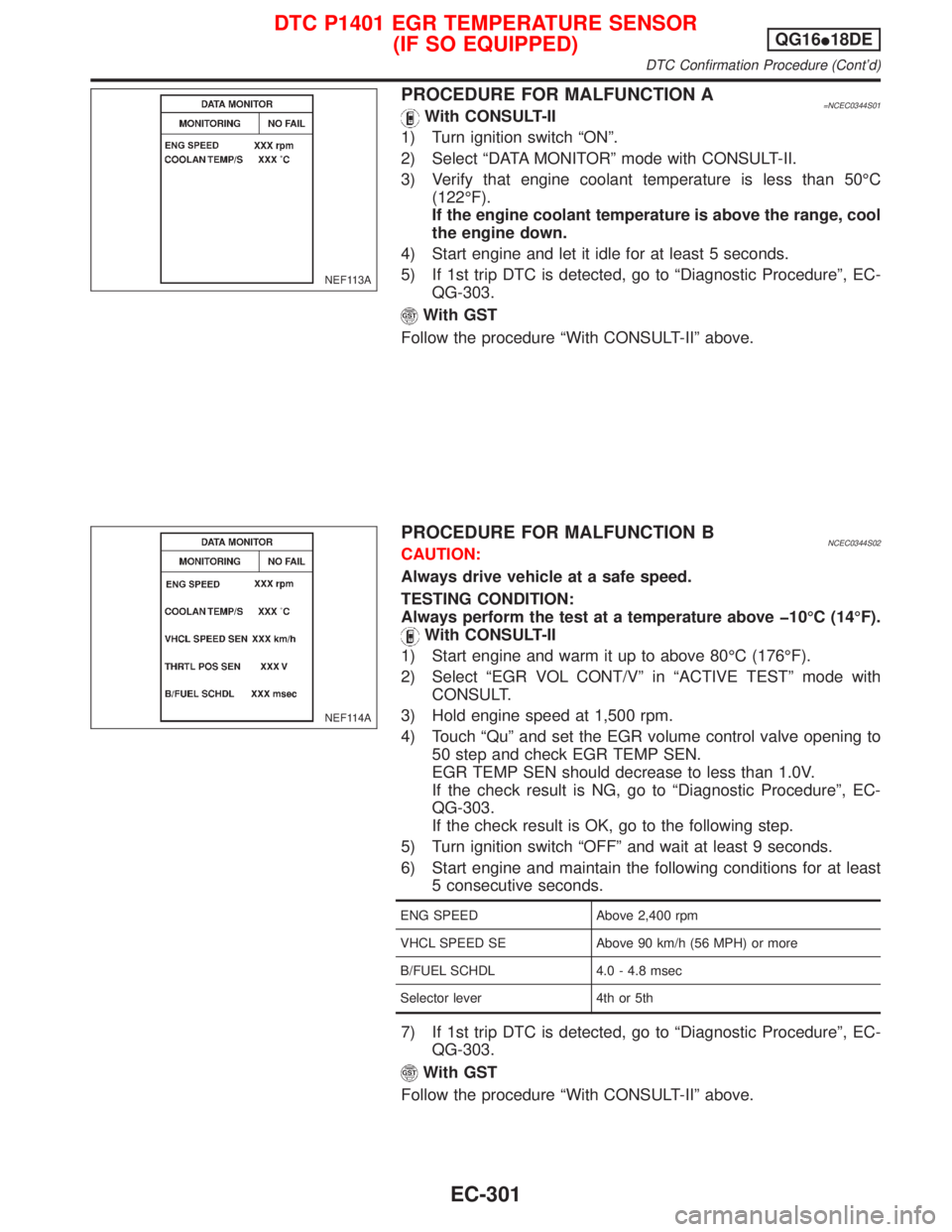
PROCEDURE FOR MALFUNCTION A=NCEC0344S01With CONSULT-II
1) Turn ignition switch ªONº.
2) Select ªDATA MONITORº mode with CONSULT-II.
3) Verify that engine coolant temperature is less than 50ÉC
(122ÉF).
If the engine coolant temperature is above the range, cool
the engine down.
4) Start engine and let it idle for at least 5 seconds.
5) If 1st trip DTC is detected, go to ªDiagnostic Procedureº, EC-
QG-303.
With GST
Follow the procedure ªWith CONSULT-IIº above.
PROCEDURE FOR MALFUNCTION BNCEC0344S02CAUTION:
Always drive vehicle at a safe speed.
TESTING CONDITION:
Always perform the test at a temperature above þ10ÉC (14ÉF).
With CONSULT-II
1) Start engine and warm it up to above 80ÉC (176ÉF).
2) Select ªEGR VOL CONT/Vº in ªACTIVE TESTº mode with
CONSULT.
3) Hold engine speed at 1,500 rpm.
4) Touch ªQuº and set the EGR volume control valve opening to
50 step and check EGR TEMP SEN.
EGR TEMP SEN should decrease to less than 1.0V.
If the check result is NG, go to ªDiagnostic Procedureº, EC-
QG-303.
If the check result is OK, go to the following step.
5) Turn ignition switch ªOFFº and wait at least 9 seconds.
6) Start engine and maintain the following conditions for at least
5 consecutive seconds.
ENG SPEED Above 2,400 rpm
VHCL SPEED SE Above 90 km/h (56 MPH) or more
B/FUEL SCHDL 4.0 - 4.8 msec
Selector lever 4th or 5th
7) If 1st trip DTC is detected, go to ªDiagnostic Procedureº, EC-
QG-303.
With GST
Follow the procedure ªWith CONSULT-IIº above.
NEF113A
NEF114A
DTC P1401 EGR TEMPERATURE SENSOR
(IF SO EQUIPPED)QG16I18DE
DTC Confirmation Procedure (Cont'd)
EC-301
Page 746 of 2267
5 CHECK EGR VOLUME CONTROL VALVE
Refer to ªComponent Inspectionº, EC-QG-251.
OK or NG
OK©GO TO 6.
NG©Replace EGR volume control valve.
6 CHECK INTERMITTENT INCIDENT
Perform ªTROUBLE DIAGNOSIS FOR INTERMITTENT INCIDENTº, EC-QG-102.
©INSPECTION END
Component InspectionNCEC0348EGR TEMPERATURE SENSORNCEC0348S01Check resistance change and resistance value.
EGR temperature
ÉC (ÉF)Voltage
VResistance
MW
0 (32) 4.56 0.62 - 1.05
50 (122) 2.25 0.065 - 0.094
100 (212) 0.59 0.011 - 0.015
If NG, replace EGR temperature sensor.
SEF643Q
SEF068X
DTC P1401 EGR TEMPERATURE SENSOR
(IF SO EQUIPPED)QG16I18DE
Diagnostic Procedure (Cont'd)
EC-304